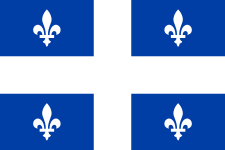De luchtkwaliteitsgegevens voor Montreal en Quebec zijn al een tijdje beschikbaar, maar we hebben onlangs enkele vragen gekregen over de AQI-schaal die in dit deel van Canada wordt gebruikt. Eén ervan is van Marie A., die vroeg:
Ik zou graag willen weten waarom de luchtkwaliteitsindex op uw website verschilt van de AQI op de website van Montreal? Berekent u iets opnieuw om aan de Amerikaanse EPA AQI-normen te voldoen? Zo ja, hoe? Met welke gegevens?
Op de datum 14 juli 14.00 uur variëren de meeste indexen op uw website bijvoorbeeld van 53 tot 65 (één index is 37) en het wordt verondersteld realtime AQI te zijn. Op de website van Montreal City , gedateerd 14 juli 14.00 uur, variëren de meeste indexen van 16 tot 37 en het is ook realtime AQI.
Kunt u mij het verschil uitleggen en welke standaardgegevens u gebruikt?
Dit is inderdaad een heel goede vraag. en we zullen in dit artikel uitleggen welke verschillende schalen er worden gebruikt, hoe de schalen zich tot elkaar verhouden en hoe de conversie kan worden uitgevoerd.
oOo
Zoals we in een van onze vorige artikelen hebben uitgelegd, gebruiken alle AQI-cijfers die over het World Air Quality Index-project worden gepubliceerd momenteel [1] de Amerikaanse EPA-standaard. Noch Montreal, noch Quebec verwachten deze regel, dus dit bevestigt dat de waarden die op de pagina stad/montreal worden weergegeven, de Amerikaanse EPA-standaard gebruiken.
Dit is de reden voor het verschil tussen de resultaten van het World Air Quality Index-project en de website van de stad Montreal ( montreal.qc.ca ): De EPA (Environment Protection Agency) van de stad Montreal gebruikt zijn eigen AQI-schaal, die duidelijk wordt beschreven op dezelfde website. Om het iets "complexer" te maken, gebruikt Quebec feitelijk een andere AQI-schaal ( gespecificeerd op deze link ) vergeleken met Montreal (tabarnac!). En natuurlijk gebruikt Canada nog een andere schaal, genaamd AQHI voor Air Quality Health Index – maar daarover schreven we al in een ander artikel .
De samenvatting van de AQI-breekpunten in Montreal en Quebec staat in deze tabel:
| Pollutant | Quebec | Montreal | ||
|---|---|---|---|---|
| Averaging Period | Reference Value | Averaging Period | Reference Value | |
| Fine Particles (PM2.5) | 3 hours | 35µg/m3 | 3 hours | 35µg/m3 |
| Ozone (O3) | 1 hour | 82 ppb | 1 hour | 160 µg/m3 |
| Nitrogen dioxide (NO2) | 1 hour | 213 ppb | 1 hour | 400 µg/m3 |
| Sulfur dioxide (SO2) | 4 minutes mobile | 213 ppb | 10 minutes mobile | 500 µg/m3 |
| Carbon monoxide (CO) | 1 hour | 30 ppm | 1 hour | 35 µg/m3 |
oOo
Om de waarden om te rekenen naar de Amerikaanse EPA-standaard zijn de ruwe concentraties uitgedrukt in milligrammen of ppb/ppm (deeltjesaantal per miljard/miljoen) nodig.
Helaas leveren noch Montreal, noch de provincie Quebec deze ruwe concentraties. In plaats daarvan verstrekken ze alleen de luchtkwaliteitsmetingen die al zijn omgezet naar hun eigen respectieve AQI-schalen. Maar dit is eigenlijk geen probleem, omdat de omzetting naar concentratie kan worden gedaan met behulp van deze eenvoudige lineaire formule:
Raw concentration (pollutant) = Reference value (pollutant) * AQI }(pollutant) / 50Als bijvoorbeeld een PM 2,5 AQI-waarde van 18 wordt gepubliceerd op de website van de stad Montreal, dan is de ruwe concentratie in milligrammen 18*35/50 = 12,6 mg/m3. Let op: voor Ozon, CO, SO 2 en NO 2 is de eenheid verschillend voor Quebec en Montreal (ppb voor Quebec - US standaard, en mg voor Montreal EU standaard), maar dat is slechts een extra omrekening (deels uitgelegd in dit artikel ) .
Merk op dat de PM 2,5 AQI gebaseerd is op het gemiddelde over 3 uur, terwijl voor het World Air Quality Index-project de uurlijkse PM 2,5 Instant Cast AQI-rapportage wordt gebruikt. Omdat het niet mogelijk is om de uurgegevens af te trekken van het 3-uursgemiddelde, betekent dit feitelijk dat de PM 2,5 AQI gerapporteerd over het World Air Quality Index-project voor Montreal en Quebec niet bepaald een "Instant Cast"-rapportage is.
oOo
Als laatste is hier de visuele vergelijking van 3 AQI-schalen (US EPA, Quebec en Montreal) voor PM 2,5 en ozon (merk op dat voor ozon de ppm-eenheid wordt gebruikt - dus de conversie van mg naar ppm wordt gedaan voor Montreal) .
Een interessant punt om op te merken is dat zowel Quebec als Montreal de AQI-waarde van 25 gebruiken als het breekpunt tussen Goed (groen) en Acceptabel (geel), terwijl dit breekpunt voor de Amerikaanse EPA op 50 is gesteld. Dus al met al Bij het vergelijken van Apple-to-Apple met de juiste conversie en breekpunten in gedachten, is het gerapporteerde AQI-bereik zeer vergelijkbaar tussen de Amerikaanse EPA-standaard en de Quebec / Montreal-standaarden.
--
Voor meer informatie over specifieke landen of continenten verwijzen wij u naar deze artikelen: Thailand en Maleisië - Indië - China - Hong Kong / Canada (Luchtkwaliteit Gezondheidsindex) - Zuid-Amerika - Australië - Québec en Montreal - Singapore - Polen - Indonesië .
Voor informatie over het gebruikte 24-uursgemiddelde van ozon en fijnstof (PM 2.5 ), verwijzen wij u naar deze twee artikelen: Ground Ozone Index - PM 2.5 Instant Cast

